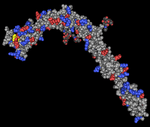Anti-apolipoprotein antibodies
In autoimmune disease, anti-apolipoprotein H (AAHA) antibodies, also called anti-β2 glycoprotein I antibodies, comprise a subset of anti-cardiolipin antibodies and lupus anticoagulant. These antibodies are involved in sclerosis and are strongly associated with thrombotic forms of lupus.[1] As a result AAHA are strongly implicated in autoimmune deep vein thrombosis.
| Autoantibody | |
|---|---|
| Anti-Apolipoprotein, β-2 Glycoprotein 1 | |
| Autoantigen Isoform | Apolipoprotein H |
| Autoantigen gene | APOH |
| Affected organ(s) | Cardiovascular |
| Affected tissue(s) | serum |
| Affected cell(s) | blood platelets |
| Also Affected | serum proteins |
| Associated Disease(s) | Idiopathic Thrombosis, Sclerosis, Systemic lupus erythematosus |
| DR4-DQ3 | |
| HLA associations | DR53 |
| DRB1*0402 (DR4) | |
Also, it was proposed that AAHA is responsible for lupus anticoagulant. However, antiphospholipid antibodies bind phospholipids at sites similar to sites bound by anti-coagulants such as PAP1 sites and augment anti-coagulation activity.[2] This contrasts with the major, specific, activity of AAHA, defining a subset of anti-cardiolipin antibodies that specifically interacts with Apo-H.[3] AHAA only inhibits the anti-coagulation activity in the presence of Apo-H and the AAHA component of ACLA correlates with a history of frequent thrombosis.[4] This can be contrasted with lupus anticoagulant which inhibits agglutination in the presence of thrombin. A subset of AHAA appear to mimic the activity of lupus anticoagulant and increase Apo-H binding to phospholipids.[5] These two activities can be differentiated by the binding to Apo-H domains, whereas binding to the 5th domain promotes that anti-coagulant activity binding to the more N-terminal domains promotes lupus anticoagulant-like activities.

AAHA interferes with factor Xa inhibition by Apo-H increasing factor Xa generation. However, like Apo-H the Lupus anticoagulant inhibits factor Xa generation.[6]
AAHA also inhibited the autoactivation of factor XII [7] while at high AAHA concentrations, factor XIIa activation increases at levels comparable to Apo-H that cause inhibition of factor XIIa activation. A synchronized inhibition of factor XII autoactivation by Apo-H and AHAA has been suggested.
Genetics
The haplotype HLA-DR4-DQ3 appears to play a role in the pathogenic AAHA production. The alleles primarily recognized are HLA-DR53[8] (DRB4*01), DRB1*0402,[9] DQA1*03,[10] and possibly DQB1*0302. All of these alleles are in linkage disequilibrium in the DRB4*01:DRB1*0402:DQA1*0301:DQB1*0302 haplotype, also called DR4-DQ8 and also the DQA1:0303:DQB1*0301 haplotype, DR4-DQ7.3. However in European Americans which reflects a broad area of Europe in which the original studies were conducted only DR4(0402)-DQ8 was found, indicating that the entire haplotype is involved.[11]
HLA-DR7 may also be associated with these antibodies and the common haplotype association is the HLA-DR53 serotype.
References
- Viard JP, Amoura Z, Bach JF (1991). "[Anti-beta 2 glycoprotein I antibodies in systemic lupus erythematosus: a marker of thrombosis associated with a circulating anticoagulant]". Comptes Rendus de l'Académie des Sciences, Série III (in French). 313 (13): 607–12. PMID 1782567.
- Sammaritano LR, Gharavi AE, Soberano C, Levy RA, Lockshin MD (1992). "Phospholipid binding of antiphospholipid antibodies and placental anticoagulant protein". J. Clin. Immunol. 12 (1): 27–35. doi:10.1007/BF00918270. PMID 1372614.
- Galli M, Bevers EM, Comfurius P, Barbui T, Zwaal RF (1993). "Effect of antiphospholipid antibodies on procoagulant activity of activated platelets and platelet-derived microvesicles". Br. J. Haematol. 83 (3): 466–72. doi:10.1111/j.1365-2141.1993.tb04672.x. PMID 8485053.
- Tsutsumi A, Matsuura E, Ichikawa K, et al. (1996). "Antibodies to beta 2-glycoprotein I and clinical manifestations in patients with systemic lupus erythematosus". Arthritis Rheum. 39 (9): 1466–74. doi:10.1002/art.1780390905. PMID 8814057.
- Takeya H, Mori T, Gabazza EC, et al. (1997). "Anti-beta2-glycoprotein I (beta2GPI) monoclonal antibodies with lupus anticoagulant-like activity enhance the beta2GPI binding to phospholipids". J. Clin. Invest. 99 (9): 2260–8. doi:10.1172/JCI119401. PMC 508058. PMID 9151800.
- Shi W, Chong BH, Hogg PJ, Chesterman CN (1993). "Anticardiolipin antibodies block the inhibition by beta 2-glycoprotein I of the factor Xa generating activity of platelets". Thromb. Haemost. 70 (2): 342–5. doi:10.1055/s-0038-1649577. PMID 8236146.
- Schousboe I, Rasmussen MS (1995). "Synchronized inhibition of the phospholipid mediated autoactivation of factor XII in plasma by beta 2-glycoprotein I and anti-beta 2-glycoprotein I". Thromb. Haemost. 73 (5): 798–804. doi:10.1055/s-0038-1653871. PMID 7482406.
- Hattori N, Kuwana M, Kaburaki J, Mimori T, Ikeda Y, Kawakami Y (2000). "T cells that are autoreactive to beta2-glycoprotein I in patients with antiphospholipid syndrome and healthy individuals". Arthritis Rheum. 43 (1): 65–75. doi:10.1002/1529-0131(200001)43:1<65::AID-ANR9>3.0.CO;2-I. PMID 10643701.
- Galeazzi M, Sebastiani GD, Tincani A, et al. (2000). "HLA class II alleles associations of anticardiolipin and anti-beta2GPI antibodies in a large series of European patients with systemic lupus erythematosus". Lupus. 9 (1): 47–55. doi:10.1177/096120330000900109. PMID 10715100.
- Ioannidis JP, Tektonidou MG, Vlachoyiannopoulos PG, et al. (1999). "HLA associations of anti-beta2 glycoprotein I response in a Greek cohort with antiphospholipid syndrome and meta-analysis of four ethnic groups". Hum. Immunol. 60 (12): 1274–80. doi:10.1016/S0198-8859(99)00122-6. PMID 10626742.
- Klitz W, Maiers M, Spellman S, et al. (2003). "New HLA haplotype frequency reference standards: high-resolution and large sample typing of HLA DR-DQ haplotypes in a sample of European Americans". Tissue Antigens. 62 (4): 296–307. doi:10.1034/j.1399-0039.2003.00103.x. PMID 12974796.